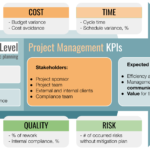Project managers (PMs) know that having key performance indicators (KPIs) is the only way to gauge a project’s success and improve upon your work formula for the future. KPIs should be closely linked to your company goals so it’s important to define success for yourself and your team.
Whatever you want to achieve, it should be easily measurable. Do you want to bring in more revenue? Gain more social impressions? Decrease the number of error reports per project?
Once you have a goal, you can decide what KPIs matter most to you.
Here are a few KPIs you might consider:
Growth & development KPIs
Let’s start with the basics. Everyone wants their business to grow. These KPIs can track whether growth is happening at an appropriate rate for you.
1. Number of potential leads
Before you have customers, you’ll need to have leads. One of the first KPIs you should be measuring are:
- How many leads do you have?
- Where are these leads coming from?
- Who is researching and vetting each lead for quality?
- How many work hours are spent doing this?
Cold calls and emails may work for you at first but as you scale as a business, you will want to incorporate different networking and advertising tactics to make sure your growth doesn’t stagnate.
2. Number of active projects

Project management software will be your best friend as the number of jobs you take on continues to grow. As this happens, you’ll want to start tracking which “leads” turn into “paying clients.”
Because it is easier and cheaper to retain clients rather than source new ones, you should also keep track of how many active projects are coming from returning customers.
Project process KPIs
Now it’s time to think about KPIs that refine your process. Various project planning tools will definitely help you track important KPIs in this area. There are free ones available online, so don’t feel like you need to break the bank getting the right software support.
3. Labor costs per task
How many hours are you spending on each task within a project? While some activities are more sporadic and harder to measure (answering emails, for example), others are easier and more vital to block out and track (like time spent QA testing an app or website).
This will help you tighten up any areas that need productivity improvement. Up-to-date KPIs in time management will also help you provide clients with better, more accurate estimates for future projects.
4. Task backlog

This might end up being a daily- or weekly-tracked KPI. Frequently, you’ll want to survey the number of tasks in your queue to gauge where processes are being bottlenecked. This can also help you assign resources or decide to bring on a new hire.
You might need to reassess urgency so that outstanding jobs are given the TLC they deserve. Or, you might decide to scrap optional/quality-of-life jobs in order to make room for bigger items.
5. Time to market
How long does it take you to complete a project? That means all the way from conception to customer sign-off. Different types of projects will take different amounts of time, ranging from hours to months (or even years).
That’s why you’ll want KPIs that indicate the type of the project, the estimated timeline, any bumps along the way, and the final (billed for) time. You will want to know how much time different phases take, like planning, executing, and QA testing.
Tracking these numbers will also let you know whether your team is getting more efficient as their experience levels increase—which should be the goal!
Quality Assurance KPIs
Quality, quality, quality. That’s what customers expect from you. And that’s what you are going to give them. These KPIs will help you get there.
6. Problems or issues found by a team

Bug tracking tools will be your saving grace when it comes to KPIs relating to quality assurance.
Ideally, you want no errors. Ever. But we know that that is never going to happen.
You will want to set up a robust measurement system to determine how many errors YOU are able to find before the product ever goes live.
7. Problems or issues found by a customer
While similar to the above KPI, you’ll want to pay particular attention to how many bugs slip passed your team’s keen eyes. You will want to keep this number low. Your customers are counting on you to deliver a perfectly polished product.
Make sure the number of bugs that makes it out into the wild is minimal. Constantly strive to lower your rate of errors.
Think:
- Where do problems arise?
- What caused them?
- How can you do better next time?
8. Client satisfaction

Probably, no one likes getting those “Rate our customer service” emails directly after a help desk call or virtual chat. But there is a good reason why big name companies continue to bombard our inboxes with them.
Some ways to measure this include:
- Using an email survey.
- Noting customer retention rate.
- Asking clients to leave a star-review on Google, Yelp, or other online services.
- Asking for a testimonial for your website.
It can be a hard statistic to track but it’s worth the effort to do so.
Project success KPIs
9. Return on investment (ROI)
Whatever resources you put in to a project, they should be counterbalanced by a measurable profit. This seems obvious but you need to think about how to measure this if financial gains aren’t your only goal.
What if you buy ad space somewhere for exposure, more so than sales? Then the KPI you might track would be website hits, traffic, or impressions. Sometimes you need to put a dollar value on your time or physical resources in order to determine if your ROI per job is acceptable.
Make sure to quantify everything that goes into a project so that you can properly measure your ROI.
10. Conversion rate

Turning “potential customers” into “paying customers” can be a tough task, particularly in an online environment where you don’t have a smooth-talking salesperson greeting people at the front door.
How many people window shop (visit your website, fill out a contact form, ask for an estimate)? And how many of those people end up making a purchase?
Keep abreast of average conversion rates across your industry and medium (Facebook shop versus Shopify stores, for example) for an idea of where to set your goals.
Conclusion
PM KPIs should be SMART: Specific, Measurable, Achievable, Relevant (or Result-Oriented), and Timely. Chances are, a good project will have more than 10 reliable KPIs. However, the ones listed above are a good place to start.
by : Ben Aston






